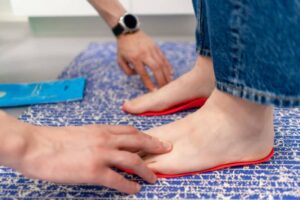Podiatrist Adelaide: Podiatry for Ingrown Toenails
Getting an ingrown toenail is painful, but it can also be dangerous. It’s important to see a podiatrist for this issue, especially for those with diabetes or poor circulation.
An ingrown treatment podiatrist Adelaide can offer a treatment plan that may include trimming the toenail, using a soaking solution, and even performing safe procedures for more serious cases.
1. Prevention
 The best way to prevent ingrown toenails is with proper foot care. It includes wearing shoes with plenty of room for the toes, keeping the feet dry and, if possible, trimming the toenails straight across using clean, sharp nail clippers without tapering or rounding the corners. It is also important to soak the feet in warm water a few times a day to help soften the nails and keep them from growing into the skin.
The best way to prevent ingrown toenails is with proper foot care. It includes wearing shoes with plenty of room for the toes, keeping the feet dry and, if possible, trimming the toenails straight across using clean, sharp nail clippers without tapering or rounding the corners. It is also important to soak the feet in warm water a few times a day to help soften the nails and keep them from growing into the skin.
A podiatrist can provide tailored treatment for ingrown toenails, from conservative measures like proper nail trimmer instruction and footwear advice to more advanced procedures performed under sterile conditions to minimize infection. For a mild ingrown toenail, the doctor may gently lift the edge of the nail and place cotton, dental floss or a splint under it. It separates the toenail from the surrounding skin and helps it grow above the skin’s edge, which usually occurs within two to 12 weeks.
For severe ingrown toenails, the podiatrist may numb your toe before removing the part of the nail that is cutting into the skin (partial nail plate excision). It reduces pain and inflammation but increases the risk of the toenail growing back deformed.
Occasionally, the doctor will remove all of your ingrown toenails (full nail plate excision). It requires a local anaesthetic and is generally performed under the supervision of an experienced physician or nurse. However, this will increase the likelihood that your toenail will come back misshapen and require repeated treatments.
Most ingrown toenails can be treated at home with warm soaks, proper nail trimming and avoiding shoes that squeeze the toes. If you have a serious case, you should see the ingrown treatment podiatrist Adelaide right away because of the potential complications and infections that can develop.
2. Diagnosis
Ingrown toenails occur when the corners or sides of a nail curve downward and dig into the skin, usually at the side of the big toe. The digging in irritates the skin and can cause pain, redness, swelling and warmth. If the toenail is infected, the area may ooze or have a foul smell. This foot condition usually develops in adults but can affect children as well. It can also be inherited.
If you suspect you have an ingrown toenail, see a doctor as soon as possible for diagnosis and treatment. It will prevent the infection from spreading through the skin around your toe and into the bone.
Your healthcare provider can diagnose an ingrown toenail by examining the toe. In some cases, your doctor may need to take a small sample of the tissue surrounding the ingrown nail. You may also need an X-ray to show how deep the ingrown toenail has grown into the skin.
Non-surgical treatments can often resolve ingrown toenails without further complications. If the ingrown toenail is not responding to home treatment, a podiatrist or other foot care specialist can remove it surgically.
Taking care of your feet is an important part of overall good health, especially for people who have diabetes or poor circulation. If you have a toenail that is painful, red or swollen, you should visit a foot care specialist as soon as possible.
3. Treatment
Ingrown toenails that have been left untreated often become infected. It can cause pain, redness, swelling, and pus around the toenail. An infected ingrown toenail should be treated right away by a foot doctor. Left untreated, the infection could spread to other parts of the body, including the bone and skin. A foot and ankle specialist can prescribe antibiotics to treat the infection if needed.
If your ingrown toenail is minor and the pain hasn’t gotten worse in a few days, home treatments may help. Soak your feet in warm water for about 15 to 20 minutes 3 or 4 times a day, using a bit of cotton or waxed dental floss to push back the edge of the nail that is digging into your skin. You can also try to trim the ingrown portion of your nail with clean toenail clippers, but only if it is safe to do so.
If home treatment doesn’t help or you have a bacterial (fungal) infection, your ingrown treatment podiatrist Adelaide, can do some surgical procedures to help. The procedure may include partial nail removal or full nail plate avulsion. In these cases, your podiatrist will numb your toe and remove the part of the nail that is digging into your skin. The rest of the nail will grow back. Your podiatrist may also use other techniques to correct the deformity of your nail if necessary.





Comments are Disabled